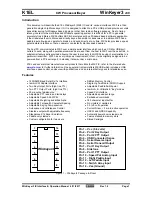
97
5.4
Watch Mode
5.4.1
Transition to Watch Mode
The system goes from active or subactive mode to watch mode when a SLEEP instruction is
executed while the SSBY bit in SYSCR1 is set to 1 and bit TMA3 in TMA is set to 1.
In watch mode, operation of on-chip peripheral modules other than timer A is halted. As long as a
minimum required voltage is applied, the contents of CPU registers and some registers of the on-
chip peripheral modules*, and the on-chip RAM contents, are retained. I/O ports keep the same
states as before the transition.
Note: * The contents of SCI3, DTMF generator registers are reset.
5.4.2
Clearing Watch Mode
Watch mode is cleared by an interrupt (timer A, IRQ
0
, WKP
0
to WKP
7
) or by a low input at the
RES
pin.
Clearing by Interrupt: When watch mode is cleared by a timer A, IRQ
0
, or WKP
0
to WKP
7
interrupt request, the mode to which a transition is made depends on the settings of LSON in
SYSCR1 and MSON in SYSCR2. If both LSON and MSON are cleared to 0, transition is to active
(high-speed) mode; if LSON = 0 and MSON = 1, transition is to active (medium-speed) mode; if
LSON = 1, transition is to subactive mode. When the transition is to active mode, after the time set
in SYSCR1 bits STS2 to STS0 has elapsed, a stable clock signal is supplied to the entire chip,
watch mode is cleared, and interrupt exception handling starts. Watch mode is not cleared if the I
bit of CCR is set to 1 or the particular interrupt is disabled in the interrupt enable register.
Clearing by
RES
Input: Clearing by
RES
pin is the same as for standby mode; see 5.3.2,
Clearing Standby Mode.
5.4.3
Oscillator Settling Time after Watch Mode is Cleared
The waiting time is the same as for standby mode; see 5.3.3, Oscillator Settling Time after
Standby Mode is Cleared.
















































